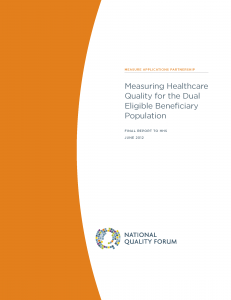 The National Quality Forum has released on a report on “Measuring Healthcare Quality for the Dual Eligible Beneficiary Population.” The report presents a national performance measurement strategy for the dual eligible population.
The National Quality Forum has released on a report on “Measuring Healthcare Quality for the Dual Eligible Beneficiary Population.” The report presents a national performance measurement strategy for the dual eligible population.
According to the executive summary:
“The focus on a population — particularly one where an innovative approach is needed — creates both opportunities and challenges with respect to measurement. Although there is increased awareness that the next generation of performance measurement should more nimbly follow a patient through many care experiences, rather than one disease in one setting at a time, this measurement vision will take time to achieve. This report presents a measurement roadmap to assessing care for complex populations across multiple types of settings and providers.”
The Department of Health and Human Services (HHS) engaged the Measure Applications Partnership (MAP), a multi-stakeholder group of public and private-sector organizations and experts convened by the National Quality Forum (NQF), to write the report.
For more information and to access the report, click here.
The report identifies the following core aspects of care that could provide “high-value signals of improvement” over time:
- Individuals’ quality of life and functional status—including symptom control, progress toward treatment and recovery goals and, in time, psychosocial factors such as level of engagement in community activities.
- Individuals’ preferences and experience of care, and engagement in decisions about their care;
- The coordination of care among multiple providers and facilities, particularly when a dual eligible beneficiary transitions from one care setting to another (from a hospital to a nursing home or home care, for example);
- The continual need for follow-up care and the availability of community support services and systems; and
- The ongoing management of chronic health conditions and the risks for chronic conditions.
